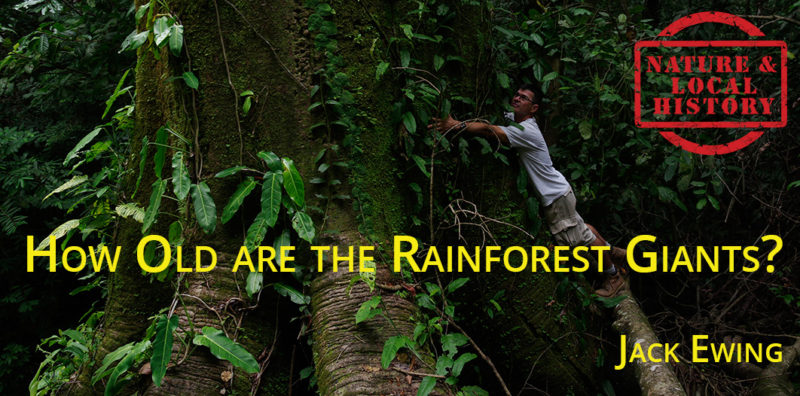How Old Are The Rainforest Giants?
When I was in junior high school, now called middle school, I was fortunate to have an exceptional science teacher who’s lectures were so interesting that I still remember much of what I learned in that class. I still remember the day we learned about determining the age of trees by counting the growth rings. In a temperate climate, metabolic activity is dormant during the cold winter months, and the tree doesn’t grow. Then when summer comes along the trunk will increase in girth by adding another ring. Since there is a new ring each year, counting the rings will tell us how old the tree was. Today this can be done on a living tree without cutting it down. A small core is cut from the trunk and the rings counted on the core.
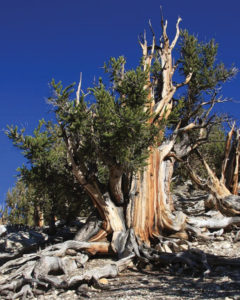 Searching the internet for the world’s oldest trees will take you to a number of web sites with listings of some of the most likely candidates. Of the trees whose ages have been confirmed with a core sample, the distinction of being the oldest living tree is almost certainly held by a Great Basin Bristlecone Pine located in the western United States, and it is probably over 5000 years old. Some sources list a tree of this species named Methuselah from which a core was drilled in 1957 and determined to have 4789 rings at that time. An unnamed individual of this same species is listed by some sources as more than 5000 years old. Most of these very old trees are from dry climates, and the forests where they are found are practically all the same species. No rainforest trees are found among the oldest living individuals. A rainforest is, of course, very wet, and it contains a multitude of species. A single hectare could easily have 100 different kinds of trees.
Searching the internet for the world’s oldest trees will take you to a number of web sites with listings of some of the most likely candidates. Of the trees whose ages have been confirmed with a core sample, the distinction of being the oldest living tree is almost certainly held by a Great Basin Bristlecone Pine located in the western United States, and it is probably over 5000 years old. Some sources list a tree of this species named Methuselah from which a core was drilled in 1957 and determined to have 4789 rings at that time. An unnamed individual of this same species is listed by some sources as more than 5000 years old. Most of these very old trees are from dry climates, and the forests where they are found are practically all the same species. No rainforest trees are found among the oldest living individuals. A rainforest is, of course, very wet, and it contains a multitude of species. A single hectare could easily have 100 different kinds of trees.
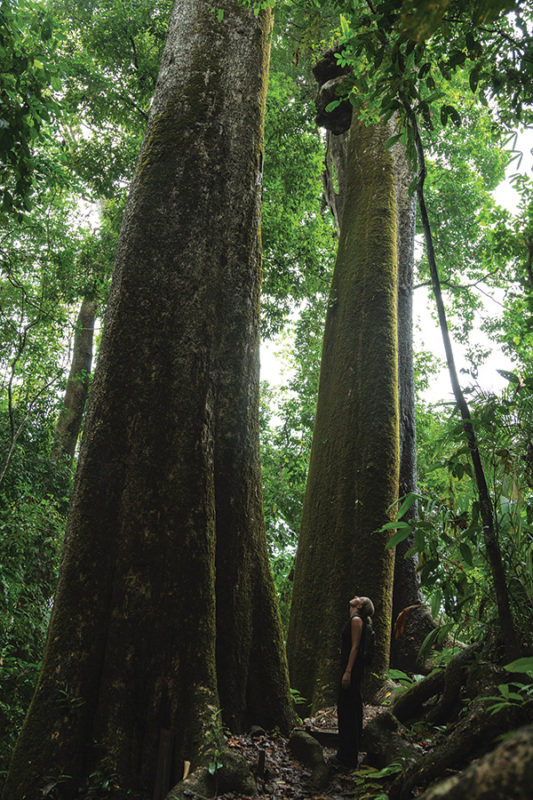 In a mature rainforest there are at least three layers of canopy which absorb most of the sunlight allowing only a small percentage to reach the ground. Let’s imagine that a seed from common tree like a lechoso, (Brosium utile), sometimes called the cow tree in English, germinates on the forest floor. In order for it to develop into one of the rainforest giants, the seedling must fight its way up through several layers of foliage and emerge into the direct sunlight. This could take years, and everything depends on the amount of the sun’s energy it is able to capture. Most of the time there will only be enough to keep it alive and growing very slightly until a nearby tree falls and opens up a clearing. When a rainforest giant falls it usually takes lots of other trees, large and small, along with it. Vines and lianas grow in the crowns of most upper canopy trees and extend from one crown to another effectively tying several trees together. When one falls, neighboring trees will be pulled down with it. Additionally the toppling giant will fall against other neighboring trees and take them down as well. What remains is a sizable clearing where an enormous amount of sunlight instantly floods in and bathes the smaller trees with life-giving energy. That’s when the race begins. Our cow tree seedling will accelerate in growth in an effort to capture as much of the sunlight as possible. Nothing in a rainforest is simple, rather it is the most complex ecosystem on the planet, but in very, very simplified form the following is what happens. The sun’s rays warm the soil, new seedlings germinate and take the place of previous seedlings, like our lechoso, which will grow taller and thicker and move up into the next level, sometimes called the lower canopy. There it will take its place along with other trees of five to ten cm in diameter and three to five meters tall. Previous occupants of the lower canopy will race to reach the next level, the middle canopy, which includes trees that don’t yet come out into the direct sun, but patiently wait their turn just under the crowns of the rainforest giants. And finally, the previous occupants of the middle canopy will fight to fill the gap once occupied by the crowns of the fallen giant and the neighbors it took down with it. When our cow tree reaches this level and emerges into the direct sunlight, it will finally take its place among the old timers of the rainforest. The time from germination until reaching the upper canopy could take upward of 100 years. We really don’t know. It all depends on how many trees fall nearby. If everything goes perfectly three tree falls will do the trick, but there are always complications, and five or six or more of these rapid growth cycles may be necessary.
In a mature rainforest there are at least three layers of canopy which absorb most of the sunlight allowing only a small percentage to reach the ground. Let’s imagine that a seed from common tree like a lechoso, (Brosium utile), sometimes called the cow tree in English, germinates on the forest floor. In order for it to develop into one of the rainforest giants, the seedling must fight its way up through several layers of foliage and emerge into the direct sunlight. This could take years, and everything depends on the amount of the sun’s energy it is able to capture. Most of the time there will only be enough to keep it alive and growing very slightly until a nearby tree falls and opens up a clearing. When a rainforest giant falls it usually takes lots of other trees, large and small, along with it. Vines and lianas grow in the crowns of most upper canopy trees and extend from one crown to another effectively tying several trees together. When one falls, neighboring trees will be pulled down with it. Additionally the toppling giant will fall against other neighboring trees and take them down as well. What remains is a sizable clearing where an enormous amount of sunlight instantly floods in and bathes the smaller trees with life-giving energy. That’s when the race begins. Our cow tree seedling will accelerate in growth in an effort to capture as much of the sunlight as possible. Nothing in a rainforest is simple, rather it is the most complex ecosystem on the planet, but in very, very simplified form the following is what happens. The sun’s rays warm the soil, new seedlings germinate and take the place of previous seedlings, like our lechoso, which will grow taller and thicker and move up into the next level, sometimes called the lower canopy. There it will take its place along with other trees of five to ten cm in diameter and three to five meters tall. Previous occupants of the lower canopy will race to reach the next level, the middle canopy, which includes trees that don’t yet come out into the direct sun, but patiently wait their turn just under the crowns of the rainforest giants. And finally, the previous occupants of the middle canopy will fight to fill the gap once occupied by the crowns of the fallen giant and the neighbors it took down with it. When our cow tree reaches this level and emerges into the direct sunlight, it will finally take its place among the old timers of the rainforest. The time from germination until reaching the upper canopy could take upward of 100 years. We really don’t know. It all depends on how many trees fall nearby. If everything goes perfectly three tree falls will do the trick, but there are always complications, and five or six or more of these rapid growth cycles may be necessary.
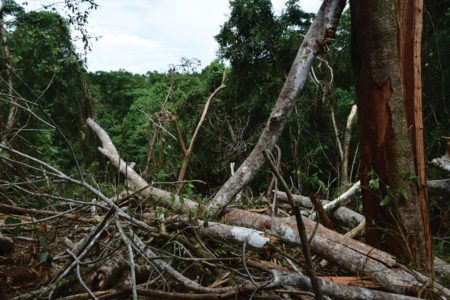 So how long does a tree live once it reaches the upper canopy? Again we really don’t know. We can only make educated guesses. 100 years ago nobody was studying the rainforest, and growth and longevity records over long periods of time are nonexistent. As of this writing I have been on Hacienda Barú for 47 years. During that time I have seen the lives of many rainforest trees of all different sizes and species come to an end. Some of these looked healthy up until the very end when something caused them to topple. A few started showing signs of deterioration such as broken or dying limbs or portions of the crown dying up, and the trees came down piece by piece. Some have looked quite healthy and then one day they just collapsed into their hollow centers. All were replaced in a short period of time by lower level trees. The tree shown in the photo of the giant tree hug and one of the two tall twins have fallen since these photos were taken. Both were a complete surprise. Both looked perfectly healthy, and the next time someone walked by they were on the ground surrounded by a big clearing.
So how long does a tree live once it reaches the upper canopy? Again we really don’t know. We can only make educated guesses. 100 years ago nobody was studying the rainforest, and growth and longevity records over long periods of time are nonexistent. As of this writing I have been on Hacienda Barú for 47 years. During that time I have seen the lives of many rainforest trees of all different sizes and species come to an end. Some of these looked healthy up until the very end when something caused them to topple. A few started showing signs of deterioration such as broken or dying limbs or portions of the crown dying up, and the trees came down piece by piece. Some have looked quite healthy and then one day they just collapsed into their hollow centers. All were replaced in a short period of time by lower level trees. The tree shown in the photo of the giant tree hug and one of the two tall twins have fallen since these photos were taken. Both were a complete surprise. Both looked perfectly healthy, and the next time someone walked by they were on the ground surrounded by a big clearing.
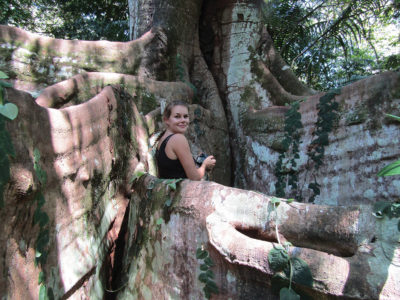 Years ago I noticed that most rainforest trees have very superficial roots. Every year during the rainy season the soil becomes so saturated with water that the water table rises all the way to the surface. Water logged soil does not provide solid footing for trees, and a heavy gust of wind in the middle of a thunder shower can topple even a healthy tree. Fallen trees with soil covered roots protruding into the air are not an uncommon sight in the rainforest. A very conservative estimate of the number of trees that fall and leave a sizable clearing, is one tree in every 10 hectares each year. Any random lechoso seedling, should be able experience an accelerated growth cycle brought on by such a clearing once every 20 years. That would be five cycles per century. If my estimate is correct, almost the entire upper canopy will be replaced every 100 years, and we can say that very few if any rainforest trees live more than two centuries, the first in the lower levels and the second with the distinction of being one of the rainforest giants. In reality, nobody knows for sure. Some carbon dating currently being done on core samples from old growth forests in the Amazon may shed some light on the subject.
Years ago I noticed that most rainforest trees have very superficial roots. Every year during the rainy season the soil becomes so saturated with water that the water table rises all the way to the surface. Water logged soil does not provide solid footing for trees, and a heavy gust of wind in the middle of a thunder shower can topple even a healthy tree. Fallen trees with soil covered roots protruding into the air are not an uncommon sight in the rainforest. A very conservative estimate of the number of trees that fall and leave a sizable clearing, is one tree in every 10 hectares each year. Any random lechoso seedling, should be able experience an accelerated growth cycle brought on by such a clearing once every 20 years. That would be five cycles per century. If my estimate is correct, almost the entire upper canopy will be replaced every 100 years, and we can say that very few if any rainforest trees live more than two centuries, the first in the lower levels and the second with the distinction of being one of the rainforest giants. In reality, nobody knows for sure. Some carbon dating currently being done on core samples from old growth forests in the Amazon may shed some light on the subject.
Jack Ewing was born and educated in Colorado. In 1970 he and his wife Diane moved to the jungles of Costa Rica where they raised two children, Natalie and Chris. A newfound fascination with the rainforest was responsible for his transformation from cattle rancher into environmentalist and naturalist. His many years of living in the rainforest have rendered a multitude of personal experiences, many of which are recounted in his published collection of essays, Monkeys are Made of Chocolate. His latest book is, Where Jaguars & Tapirs Once Roamed: Ever-evolving Costa Rica. Jack and Diane live on and manage the Hacienda Barú National Wildlife Refuge, a well-known ecotourism destination on the southwest coast of Costa Rica.

